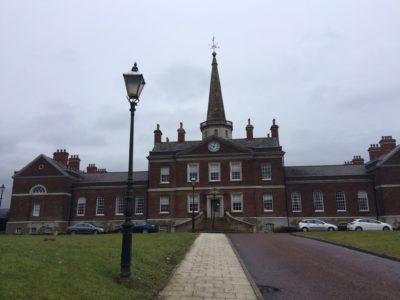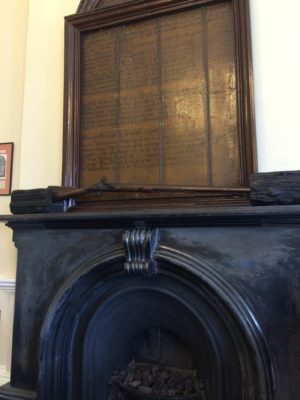Public histories of poverty
04 February 2019 – Kristin O’Brassill-Kulfan

Clifton House was built by the Belfast Charitable Institution in 1774 to serve as a poorhouse for the city of Belfast, now in Northern Ireland. It is now a preserved historic site, where visitors can take tours of the grounds and conduct research in their archives. Photo credit: Kristin O’Brassill-Kulfan
In his Congressional Gold Medal acceptance speech from 2013, Dr. Muhammad Yunus quipped that one day “soon we will visit the museum to see poverty.” Given that public historians interpret and document other social ills in museums and historic sites— sexism, racism, homophobia, ableism—where does poverty and its attendant questions of class fit in our interpretive plans? The question of whether and how we present poverty poses some interesting questions for practitioners. Dr. Yunus’s statement should prompt museums and historic sites to consider how they can answer questions that contemporaries and historical actors shared: Why are people poor? What is it like to experience poverty? How has poverty changed over time?
Museums and other historic sites are well-versed in providing the contextual information that makes it possible to answer these questions. Yet few of them do. Are we trying to avoid laying blame or appearing political? Or is there a more practical reason? In his book Mickey Mouse History, Mike Wallace explains the absence of museum interpretation of poverty as the result of a lack of material wealth possessed by the lower classes: “How do you present subjects for which you do not have objects? The poor, notoriously, leave little detritus behind,” he writes. If we collect the material culture of the poor—which does exist, but can require a bit more creativity from researchers and curators to present—we might move toward changing this narrative. There are practical concerns around this sort of collection, though; how can curators avoid the fetishization of suffering in interpreting the material culture of destitution? The field came one step closer to hashing out this problem after the 1995 archaeological excavation of the Five Points neighborhood, a deeply impoverished nineteenth-century neighborhood in New York City, which had been occupied primarily by migrants to the United States. A million artifacts that would have allowed historians to interpret their lives were stored in the basement of the U.S. Customs House, Building 6 of the World Trade Center complex and nearly all were lost on September 11, 2001.

The interior of Clifton House showcases artifacts from the building’s century as a poorhouse, including these hand-painted boards displaying charitable donations made to the poor by prominent members of Belfast society. Photo credit: Kristin O’Brassill-Kulfan
But there are other opportunities to use material culture and interpretive planning to invite visitors to consider the impact that class status has had on their own lives. In the last few years, public historians have begun to address an adjacent field with deeper commitment: labor history. As historic sites and museums make more of an effort to interpret the lived experiences of workers, the interpretation of class moves closer to the foreground. This is a real opportunity to do work on the human impacts of (de-)industrialization, capitalism, slavery, and immigration, across centuries. There seems to remain some reluctance to address poverty head-on, however, perhaps because of the class dynamics that undergird our relationship to our audiences. Even in 2019, after numerous years spent in the pursuit of diversifying our interpretation, our pools of collaborators, and our sources, most historic sites and museums still receive primarily middle and upper-class visitors. As a glance at any of the last several years’ NCPH annual meeting programs will show, public history as a field has grown significantly more intersectional in recent years. But class remains an important gap.
There are museums and sites that do interpret poverty and do it effectively. The Tenement Museum, which immerses visitors in the lived experience of tenement-dwelling working families in the late nineteenth and early twentieth centuries, is one of the best examples. Evicted, a recent exhibit about the housing crisis at the National Building Museum, explores the challenges faced by many workers resulting from low wages and high rents, charting promising new territory. Visitors to the American Labor Museum in Paterson, New Jersey, can take “Mill Worker/Mill Owner” bus tours that showcase the disparities in the lifestyles of the working people of early-twentieth-century Paterson and those who paid their wages. Preserved historic sites such as Clifton House in Belfast, Northern Ireland, an eighteenth-century almshouse, and other welfare-associated institutions, such as the Workhouse Prison Museum in Lorton, Virginia, and the National Trust-operated Workhouse in Southwell, England also fill in some important gaps on the landscape. But as a field, we are not yet close to answering the question: how should public historians interpret poverty and class? In an NCPH roundtable at the 2018 annual meeting, Kathryn Lloyd (Tenement Museum), Dan Kerr (American University), Ethan Sribnick (Montgomery College), and I attempted to answer this question by asking ourselves even more questions: How do our sources help us expand beyond the usual study of the idea of poverty? Who are our audiences, and where are the intersections between “subject” and “audience”? In documenting and interpreting these stories, how do you balance the continuity versus change over time? How do we think about language choice in interpreting poverty? We each have our own approaches to this work, but a consensus emerged around the pressing need for this work to be done, and to move the interpretation of class forward in public history. How can you do this in your own work or at your own site or institution?
~ Kristin O’Brassill-Kulfan is a public historian and scholar of early American social history at Rutgers University in New Brunswick, New Jersey. She researches poverty, slavery, mobility, crime and punishment in the early American northeast, and public historical and commemorative representations of these subjects. Her book Vagrants and Vagabonds: Poverty and Mobility in the Early American Republic was recently published by New York University Press.




I love this article. As curator of a local history organization in Wood County, Ohio, I just curated a statewide exhibit about public charity. Our museum is housed in a former poor farm site (also known as the infirmary or county home) marrying modern photographs of all 88 county poor farm sites in the state of Ohio with historical interpretation about public charity, specifically indoor relief.
Interpretation about the poor is very important because it goes beyond the basic definition related to, “people without money.” There is an opportunity to discuss a wide range of humanitarian movements of a nation, state, and locality.
Thanks for your comment, Holly. Do you have any images of the exhibit online? I’d love to check them out. I’d also like to share with a friend of mine who researches poverty and paupers in early America.
Great post and great comments! I am compiling a list of sites to visit and Lorton, Virginia and Wood County, Ohio, just joined it.
In pondering Dr. O’Brassill-Kulfan’s questions, I am reminded of Rosenzweig’s and Thelen’s The Presence of the Past. One point I took away from that book was how much visitors to historical sites would like to connect what they are seeing to their own family history. Poverty is part of many family histories. How can we help people to see their own past in almshouses?
Great article. Great topic. I am struck by the question: “how should public historians interpret poverty and class?” This makes me think of the topic of the labor movements and their impact on moving many in the poorer “classes” into the emerging middle classes. The early labor movements sometimes resulted in violent revolutions and is another story that should continue to be told. I remember a very nice museum in Terre Haute Indiana, the Eugene V. Debbs Home and Museum that talked about this topic.